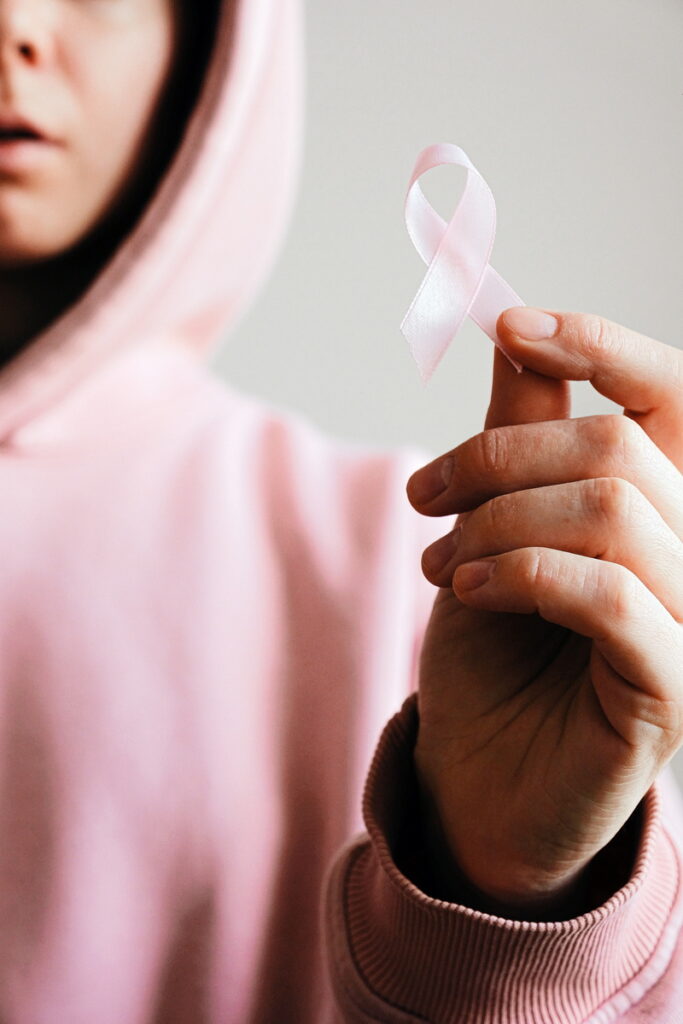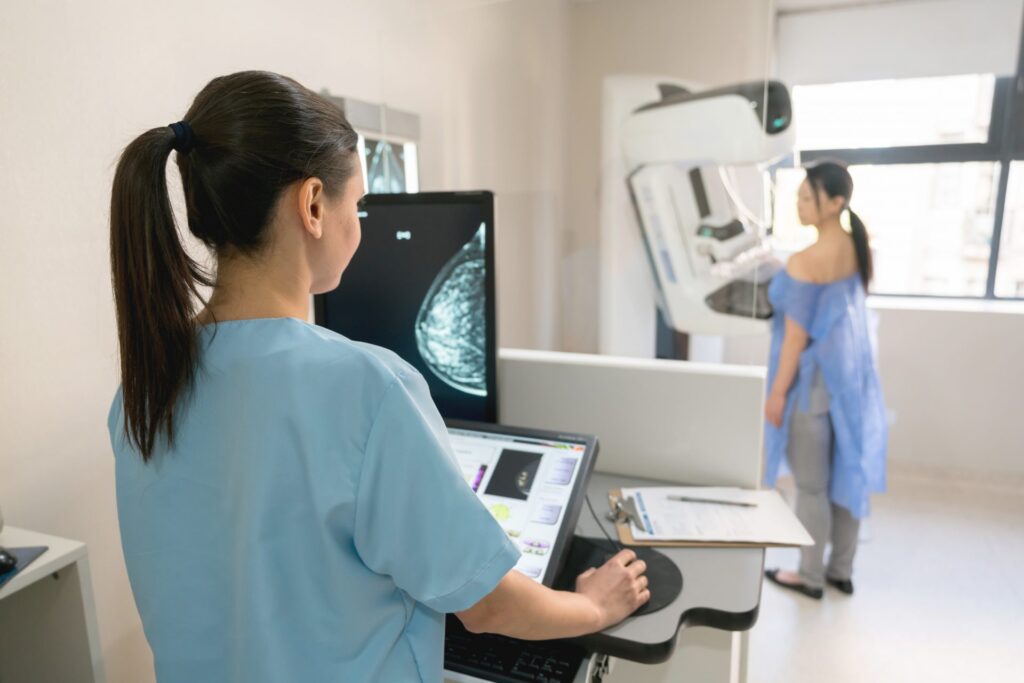Breast Cancer
Risk Factors and Prevention

What Are the Risk Factors for Breast Cancer?
Some of the known risk factors for breast cancer include age, family history, personal history of breast cancer, radiation exposure, and certain genetic mutations. The presence of one or more of these risk factors may increase the chances of developing breast cancer. Nevertheless, it is important to note that an absence of these risk factors does not rule out the possibility of developing breast cancer.
There are certain risk factors for breast cancer that you can manage, such as maintaining a healthy weight, eating a nutritious diet, and limiting alcohol consumption. However, there are other factors, such as age and family history, that are beyond your control.
Risk Factors Beyond Your Control
While breast cancer can occur at any age, the risk of developing the disease increases as you age. In Singapore, breast cancer is most commonly diagnosed in women aged 55-59 years old
If you have a close relative – your mother, sister, or grandmother who has had breast cancer, you have a higher risk of developing the disease. The risk may be even higher if the family member was diagnosed at a young age (before menopause) or if multiple family members have had breast cancer.
A family history of ovarian cancer also increases your risk of breast cancer, as the gene mutations (BRCA1 and BRCA2 genes) that cause ovarian cancer can also lead to breast cancer.
Some women inherit genes that put them at a higher risk of developing breast cancer. The most common genes linked to breast cancer are the BRCA1 and BRCA2 genes. Women with the BRCA 1 and BRCA 2 gene variant have a 55-72% and a 45-69% chance of developing breast cancer by the time they are 80 years old respectively.
Mutations in these genes are linked to an increased risk of breast and ovarian cancers, as well as other types of cancer. But it is not a certainty. Only about 2% of breast cancers are related to a change in the BRCA1 or BRCA2 genes.
Women who have higher levels of the hormone oestrogen in their bodies have a higher risk of developing breast cancer. Oestrogen is produced by the ovaries and plays a role in the development of breasts and the menstrual cycle.
As a result, women who undergo hormone therapy (eg. menopausal hormone therapy) may be at a higher risk for breast cancer due to their greater exposure to oestrogen.
Early menstruation and late menopause raise the risk of getting breast cancer. Women who start their periods at an early age (before 12 years old) or go through menopause after 55 years old have a slightly higher risk. This is because the breast cells have been exposed to oestrogen and progesterone for a longer time.
Women with certain medical conditions, such as diabetes, have a higher risk of developing breast cancer. Women who have developed breast cancer also have an increased risk of developing the disease again in either breast or the other breast.
Women with certain medical conditions, such as diabetes, have a higher risk of developing breast cancer. Women who have developed breast cancer also have an increased risk of developing the disease again in either breast or the other breast.
Women who have been exposed to high levels of radiation have an increased risk of developing breast cancer. This includes women who have had previous chest X-rays or radiation therapy for another condition. The risk goes up the younger you were when you had the radiation.


What You Can Do to Prevent Breast Cancer
Although there is no proven way to completely prevent breast cancer, you may be able to lower your risk. For those at higher risk, there are several things you can do to help reduce your risk of breast cancer. Some of these include:
Lifestyle choices to lower breast cancer risk
Drinking alcohol increases your risk of developing breast cancer. The more you drink, the greater your risk will be. It is estimated that drinking 1-2 drinks per day can lead to a 30-50% higher chance of developing breast can Hence, it is advisable to minimize your alcohol consumption especially if you already have other risk factors.
Being obese or overweight after menopause increases your risk of developing breast cancer, as well as a higher risk of cancer coming back after treatment. Fat cells produce oestrogen, which can cause breast cancer growth. It is therefore best to try to reduce the amount of fat tissue in your body.
Women who are inactive have an increased risk of developing breast cancer. Exercise helps to regulate hormone levels and reduces inflammation, both of which may help to prevent cancer. Aim for at least 30 minutes of moderate exercise on most days of the week as regular exercise can help lower your risk of developing breast cancer.
Smoking cigarettes increases your risk of developing breast cancer. Chemicals in tobacco smoke can damage DNA and prevent cells from repairing themselves, which can induce breast tumours lead to cancer.
There is some evidence that current or recent use of birth control pills can slightly increase breast cancer risk, but this risk disappears once you stop taking the pill. The risk is highest in women under 35 years old who have been taking the pill for 5 years or longer. However, there is no heightened risk of developing breast cancer in people who have stopped taking the pill for at least 10 year .
Surgery to lower breast cancer risk
Procedures like prophylactic mastectomy (surgical removal of one or both of the breasts) and prophylactic oophorectomy (removal of the ovaries) can significantly reduce your risk of breast cancer. Generally, these procedures are conducted on women who are at a very high risk of developing breast cancer, or women who have already developed breast cancer in one breast.
The preventive prophylactic mastectomy procedure appears to reduce the risk of breast cancer by at least 90% to 95%. An oophorectomy procedure can reduce the risk of developing ovarian cancer, and possibly breast cancer, by stopping the ovaries from making oestrogen.
If you’re considering having these procedures, it is important that you discuss the potential physical and emotional side effects with your doctor before undergoing these procedures.
Drugs to lower breast cancer risk
There are certain drugs such as Tamoxifen, Raloxifene or Aromatase inhibitors that may aid in the prevention of breast cancer. This is known as “chemoprevention.” This is the practice of using hormone-blocking medications to reduce the risk of breast cancer.
Tamoxifen is a drug that blocks the effects of the hormone oestrogen in the body. It can help to reduce the risk of developing breast cancer in women who are at high risk for the disease due to their age, family history, or other factors. Tamoxifen is not recommended for women with a history of blood clots, stroke, or who have been immobilized (not able to move about) for a long period.
Raloxifene is another option for reducing the risk of breast cancer in postmenopausal women and works similarly to Tamoxifen by blocking oestrogen's ability to stimulate breast cell growth. Raloxifene can be used for longer than 5 years and may reduce the risk of bone loss in addition to lowering breast cancer risk. It is not recommended for women who have not been through menopause or who have a history of blood clots, stroke, or are immobilized for a long time.
Aromatase inhibitors (AIs) are also sometimes used to prevent breast cancer. AIs are a type of drug that works by lowering the amount of oestrogen in the body by blocking oestrogen production. These drugs may be an option for postmenopausal women who are at high risk for breast cancer.
It is important to talk to your doctor about your personal risk factors for breast cancer and whether you should consider any preventive measures, such as prophylactic surgery or medications.

How to estimate your personal risk of breast cancer?
There are several breast cancer risk assessment tools that are used by doctors to estimate an individual’s risk of developing breast cancer, and advise whether to recommend prophylactic surgery, such as a mastectomy, to women at high risk for breast cancer. This section will discuss two common methods used to estimate your risk of developing breast cancer.
One of the most well-known is the Gail model. The Gail model uses information about your personal and family history, age, race, previous breast biopsies, breast density, and other factors to estimate your risk of developing invasive breast cancer over the next five years and her lifetime. It is used for women with no history of breast cancer or BRCA gene mutations.
However, the Gail model does not take into account certain lifestyle factors (alcohol consumption, diet, and exercise) and other medical conditions (benign breast conditions, hormone therapy, and previous chest radiation) that may increase or decrease breast cancer risk.
Tyrer-Cuzick tool is another risk assessment tool used to assess a woman’s risk of developing breast cancer based on her answers to a series of questions, including age at first period, weight, height, family history of breast cancer, childbearing history, menopausal status, and any use of hormone replacement therapy. The result is a risk estimate of developing invasive breast cancer specifically within ten years of her current age, as well as over the course of her lifetime.

Breast Screening
Many breast cancers have no obvious risk factors. This is why regular breast cancer screening is vital to detect breast cancers early, when they’re small and before they have had a chance to spread. It is recommended that you should go for a screening mammogram once every 2 years if you are aged 50 and above. If you have certain risk factors, screening should start earlier, at age 40, and may need to be performed once a year. Breast self-examination is also recommended once a month. The best time to do so will be a week after the start of your menstrual period.
Conclusion
There are many things you can do to reduce your risk of breast cancer. Some lifestyle choices, like maintaining a healthy weight and exercising regularly, can help lower your risk. Some women may even choose surgery to reduce the risk of breast cancer. Talk to your doctor to find out what you can do to keep your risk as low as possible.
